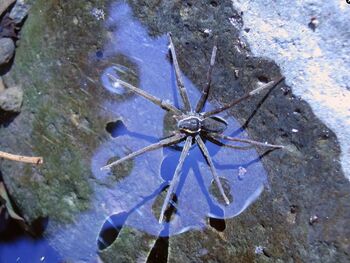| Dolomedes briangreenei | |||
|---|---|---|---|

| |||
| General information | |||
| Universe | Real Life | ||
| Classification | Dolomedes briangreenei | ||
| Species type | Wharf Spider | ||
| Homeworld | Earth | ||
| Environment | Surface of bodies of water | ||
| Intelligence | Non-Sapient | ||
| Biochemistry | Carbon-based lifeform | ||
| Discovered | 2019 | ||
| Biological information | |||
| Reproduction | Sexual; lays eggs | ||
| Locomotion | Octapodal | ||
| Feeding behavior | Liquivore | ||
| Prey | Fish, Frogs (tadpoles and adults) | ||
| Fur color | Dark brown with white or beige head stripes | ||
| Lineage information | |||
| Cultural information | |||
| Alignment | True Neutral | ||
| Sociocultral characteristics | |||
| Scientific taxonomy | |||
| Planet | Earth | ||
| Domain | Eukaryota | ||
| Kingdom | Animalia | ||
| Subkingdom | Eumetazoa | ||
| Infrakingdom | Bilateria | ||
| Superphylum | Deuterostomia | ||
| Phylum | Arthropoda | ||
| Class | Arachnida (Arachnids) | ||
| Order | Araneae (Spiders) | ||
| Suborder | Opisthothelae | ||
| Infraorder | Araneomorphae (Fangs point diagonally forward and cross in a pinching action) | ||
| Family | Pisauridae | ||
| Genus | Dolomedes | ||
| Species | briangreenei | ||
| Other information | |||
| Status | Data deficient | ||
| First sighting | 2019 | ||
Dolomedes briangreenei is a species of wharf spider indigenous to Australia.
Etymology[]
The species name, briangreenei, is in honor of the famous physicist Brian Greene, who was also the co-founder of the World Science Festival in Brisbane, Queensland where it was first revealed on March 9, 2019. This was done due to their using of vibrations across the water's surface ("waves"), and this was associated with the detections of gravitational waves only a month prior.
Physiology[]
D. briangreenei is covered in fine, velvety, hydrophobic hairs. These are primarily dark brown with some level of sexual dimorphism: Males have white stripes along the head and females instead possess beige stripes. The hydrophobic hairs allow them to repel water due to being unwettable and thus they can utilize surface tension to stand and run on the water in a manner similar to pond skaters.
Like other wharf spiders, their fine hairs serve a secondary purpose. The hydrophobic nature of their hairs traps air and forms a thin film of oxygen over the entire body, superficially giving it the appearance of polished silver. As their book lungs open beneath their abdomens and into this air film, they are actually capable of breathing while underwater. This trapped air does make them quite buoyant though and because of this if they do not grasp onto an object such as a rock or plant they will simply float back up to the surface; once they reach it they will immediately pop back up upon the surface film, completely dry.
Dietary habits[]
D. briangreenei is a larger member of their genus and they are able to predate on larger prey items, including fish and both the tadpoles and adult forms of frogs. To hunt, they will attach themselves to the shore using their back legs and spread out their remaining legs across the surface of the water. From this position the will be able to detect minuscule vibrations caused by the movement of objects beneath them in a similar manner to regular web-building spiders detect vibration through their traps. Once they detect a potential prey item they will dive beneath the surface and swim along the bottom in an attempt to grab an subdue their victims.